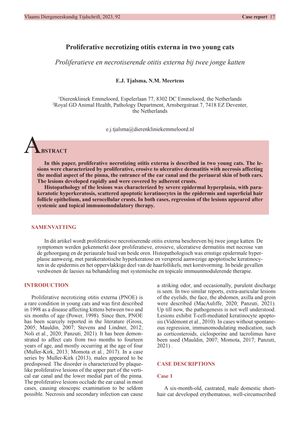TLDR Two young cats with a severe ear and skin condition improved with immune system-targeting treatments.
The paper reports on two young cats diagnosed with proliferative necrotizing otitis externa, a condition presenting with rapidly developing, crust-covered lesions affecting the ears and surrounding skin. Histopathological examination revealed severe epidermal hyperplasia, parakeratotic hyperkeratosis, and apoptotic keratinocytes. Both cats showed lesion regression following systemic and topical immunomodulatory treatments.
 20 citations
,
October 2016 in “Veterinary dermatology”
20 citations
,
October 2016 in “Veterinary dermatology” Dogs with generalized discoid lupus erythematosus have similar symptoms to humans and need continuous treatment.
 291 citations
,
January 2014 in “The Scientific World Journal”
291 citations
,
January 2014 in “The Scientific World Journal” Lichen Planus is a less common condition affecting skin and mucous membranes, with various types and associated risk factors, challenging to diagnose, significantly impacts life quality, and may have a risk of cancerous changes in oral lesions.
 3 citations
,
December 2022 in “Cells”
3 citations
,
December 2022 in “Cells” Cannabinoids like CBD and THC may help treat non-cancer skin diseases, but more research is needed.
1 citations
,
January 2025 in “Genes & Diseases” Understanding T cells and signaling pathways can lead to better treatments for hair loss.
9 citations
,
August 2021 in “International journal of molecular sciences” PPARγ is essential for maintaining healthy skin, controlling inflammation, and ensuring proper skin barrier function.




